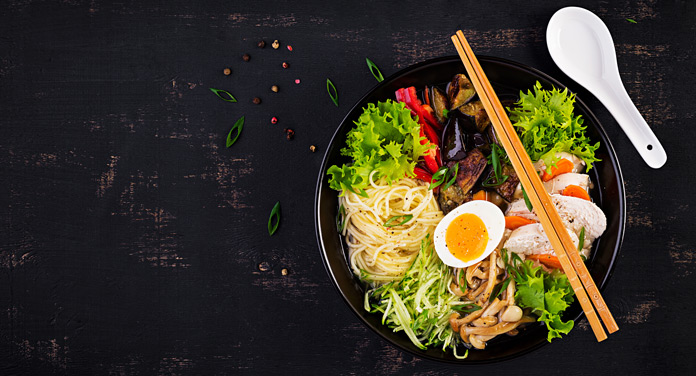There are now so many different diets that it is impossible to count them all. Starting with the keto diet, where mainly carbohydrates are eliminated from the menu, up to the paleo diet.
Here people try to eat as naturally as possible, just like Stone Age people would have done. But there is another diet or diet that is gaining popularity in our circles but has been around for a very long time: the Okinawa diet. But what about the diet of the people from the small island off Japan? And what is the secret of the residents of the “Village of Centenarians?”
The Long Life And Health Of The People Of Okinawa
Ogimi, the village of the centenarians, is located in the north of the Okinawa archipelago, which lies between the Philippines and Japan. The small town is home to almost 3,200 people and is known for the longevity of its residents. A good two-thirds of the people over 100 years old live there independently and without assistance.
It also has the largest number of centenarians in the world. In addition, according to a study, the number of cardiovascular diseases, heart attacks, strokes, and cancer is significantly lower. The average life expectancy for women is around 86 years and for men 78 years.
The healthy and natural diet of the islanders plays a key role there. This keeps long life expectancy and physical and mental health in balance. Therefore, this way of eating should not necessarily be viewed as a diet, but rather as a lifestyle. We did some research and unraveled a little bit of the Okinawan diet’s little mystery.
What Foods Are Used In The Okinawa Diet?
The first thing you will notice is that this diet consists of a lot of vegetables. The plate should be at least half-covered with vegetables. But more on the exact compositions below. This form of nutrition is also particularly high in fiber and contains few calories and fat. Did you know that the islanders consume up to 20 percent fewer calories than the rest of the Japanese?
The dishes are mostly vegetarian and rich in carbohydrates. Almost 90 percent of the diet consists of plant foods. Vegetables such as green leafy vegetables, bitter melon, and shiitake mushrooms are used very often.
In addition to the many types of vegetables, people from Ogimi mainly eat fresh fish. Red meat and poultry are very rare. Fresh fish, tofu, and other soy products are considered the most important source of protein. Sugar is as good as banned from the plate.
To get enough carbohydrates, Okinawans mostly use various root vegetables, sweet potatoes, and buckwheat soba noodles. These are then often combined with seafood, soy, vegetables, seaweed, and berries.
The 5 Basic Rules Of The Okinawa Diet
To keep track of things, the Okinawa diet has a few simple principles that you can use as a guide. We present them to you in a summarized and simple way:
1. Hara Hachi Bu
The main thing here is to observe the principle of “moderation”. The Okinawan diet stops eating when the stomach is about 80 percent full. In order to be able to feel and assess this better, emphasis is placed on mindful eating. You should therefore eat and enjoy your meal away from any distractions such as television. So you feel a lot better after every meal.
2. Kuten Gwa
Don’t put everything on one plate! Okinawans use several small plates and bowls to better divide their food. The dishes are placed in the middle of the table and the food is then eaten in a convivial atmosphere. In Japan and especially on the island, eating together is celebrated.
In addition, the food is always homemade, and only very fresh products are used for cooking. So that you can get a better idea of what such a traditional meal might look like, here is a small example: Usually there is rice as a source of starch, plus miso soup (or vegetable soup) and then three other dishes.
3. At Least Half A Plate Of Vegetables
Vegetables are an integral part of the diet and not a day goes by without vegetables being cooked and served on the plate. So you can be sure that you are getting enough nutrients. With this diet, meat, fish, or tofu take a back seat and are treated more as a side dish. There’s no such thing as a large cut of steak or roast that takes up half the space on the island.
4. Food Preparation Method
Not only is it important to eat good, healthy food, but preparing it is just as important. There are three methods of cooking in Okinawa. The first involves eating many vegetables raw or undercooked. The vitamin and mineral content remains intact and chewing performance is improved. Food is then only half cooked, which means that it is either fried or eaten al dente. Finally, food is cooked without adding fat. Meat or fish is also often cooked to prevent fat from being added when frying.
5. Sweet to Finish?
There is no real kind of dessert in Okinawa, in the form of cakes like we do. If the desire for dessert arises after a slowly eaten meal, fruit is usually used. Sometimes coffee or tea is served without sugar.
Pros and Cons of the Okinawa Diet
The benefits of this diet become apparent very quickly. It is particularly high in fiber and protein, which means that you quickly feel full. Studies also show that weight loss works very well with this type of food. The high proportion of vegetables and the associated nutrients are also good for the body.
There are hardly any disadvantages. The fixed-portion diet isn’t right for everyone. However, caution is advised if the thyroid gland is underactive or overactive or if there are blood pressure problems. If you want to implement this diet, you should talk to a doctor.





